SpringBoot Tutorial
- What is SpringBoot
- SpringBoot Project Structure
- SpringBoot Annotations
- SpringBoot AppProperties
- SpringBoot Create Application
- SpringBoot Helloworld
- SpringBoot PostMapping
- SpringBoot GetMapping
- SpringBoot DeleteMapping
- SpringBoot PutMapping
- SpringBoot CRUD Example
- SpringBoot With Docker
- What is SpringDataJPA
- SpringDataJPA with MySql
- Put and Patch
- Query from Method Name
- Query Annotation
- PagingAndSorting Repository
- SpringBoot Logging
- SpringBoot Exceptions
- SpringBoot Validations
- SpringBoot OpenAPI Docs
- SpringDataJPA Mappings
- SpringBoot Caching with Redis
- Docker MySqlDB Example
SpringBoot CRUD Example
As part of this example we're going to use following annotations to perform the CRUD operations.
- 1. PostMapping.
- 2. GetMapping.
- 3. DeleteMapping.
- 4. PutMapping.
As part of this below endpoints will be used to perform the CRUD operations.
- HTTP POST /api/v1/customer/create – create a customer.
- HTTP GET /api/v1/customer/getAll – returns all the customers in the system.
- HTTP GET /api/v1/customer/getById/{customerId} – returns a customer by specified id.
- HTTP DELETE /api/v1/customer/deleteById/{customerId} – delete a customer by specified id.
- HTTP PUT /api/v1/customer/update – update a customer by specified id.
Will perform the CRUS operation without using without database storage.
@PostMapping annotation is a simplified compact version of @RequestMapping(method-RequestMathod.POST)
@GetMapping annotation is a simplified compact version of @RequestMapping(method-RequestMathod.GET)
@DeleteMapping annotation is a simplified compact version of @RequestMapping(method-RequestMathod.DELETE)
@PutMapping annotation is a simplified compact version of @RequestMapping(method-RequestMathod.PUT)
SpringBoot provides a web tool to generate a initial bootstrap applicaiton which is Spring Initializer. If you want to learn the more about Spring initializer and how to use it to create the application visit following tutorial Create Springboot Application.
Tech stacks to develop CRUD operation
Project Strucure
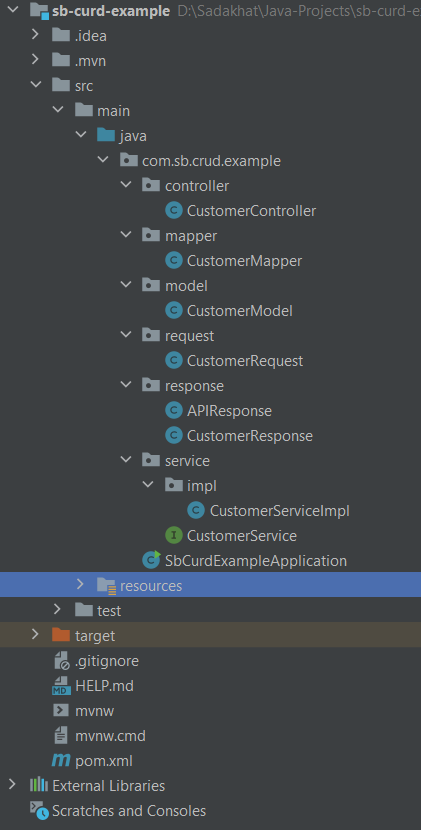
pom.xml
While generating the SpringBoot project, will make sure that to add following Maven dependencies.
<?xml version="1.0" encoding="UTF-8"?>
<project xmlns="http://maven.apache.org/POM/4.0.0" xmlns:xsi="http://www.w3.org/2001/XMLSchema-instance"
xsi:schemaLocation="http://maven.apache.org/POM/4.0.0 https://maven.apache.org/xsd/maven-4.0.0.xsd">
<modelVersion>4.0.0</modelVersion>
<parent>
<groupId>org.springframework.boot</groupId>
<artifactId>spring-boot-starter-parent</artifactId>
<version>3.3.0</version>
<relativePath/> <!-- lookup parent from repository -->
</parent>
<groupId>com.sb.crud.example</groupId>
<artifactId>sb-curd-example</artifactId>
<version>0.0.1-SNAPSHOT</version>
<name>sb-curd-example</name>
<description>Demo project for Spring Boot</description>
<properties>
<java.version>17</java.version>
</properties>
<dependencies>
<dependency>
<groupId>org.springframework.boot</groupId>
<artifactId>spring-boot-starter-web</artifactId>
</dependency>
<dependency>
<groupId>org.projectlombok</groupId>
<artifactId>lombok</artifactId>
<optional>true</optional>
</dependency>
<dependency>
<groupId>org.springframework.boot</groupId>
<artifactId>spring-boot-starter-test</artifactId>
<scope>test</scope>
</dependency>
</dependencies>
<build>
<plugins>
<plugin>
<groupId>org.springframework.boot</groupId>
<artifactId>spring-boot-maven-plugin</artifactId>
<configuration>
<excludes>
<exclude>
<groupId>org.projectlombok</groupId>
<artifactId>lombok</artifactId>
</exclude>
</excludes>
</configuration>
</plugin>
</plugins>
</build>
</project>
SbCurdExampleApplication.java
package com.sb.crud.example;
import org.springframework.boot.SpringApplication;
import org.springframework.boot.autoconfigure.SpringBootApplication;
@SpringBootApplication
public class SbCurdExampleApplication {
public static void main(String[] args) {
SpringApplication.run(SbCurdExampleApplication.class, args);
}
}
Request.java
package com.sb.post.mapping.example.request;
import lombok.*;
@Getter
@Setter
@NoArgsConstructor
@AllArgsConstructor
@EqualsAndHashCode
@Builder(toBuilder = true)
public class CustomerRequest {
private String customerName;
private int customerAge;
private String customerMobileNumber;
private String customerEmailAddress;
private String customerAddress;
}
@Getter: This annotation will help to enable the all getter methods.
@Setter: This annotation will help to enable the all setter methods.
@NoArgsConstructor: This annotation will help to enable the no argument NoArgsConstructor.
@AllArgsConstructor: This annotation will help to create the AllArgsConstructor.
@EqualsAndHashCode: This annotation will overrides the equals and hashcode method.
@Builder: This annotation will eliminates the need to write boilerplate code for constructors with many
parameters. It generates the builder class and its methods automatically. this will allow us to set only the
fields that is needed, making it easy to work with classes that have many optional attributes.
CustomerController.java
package com.sb.crud.example.controller;
import com.sb.crud.example.request.CustomerRequest;
import com.sb.crud.example.response.APIResponse;
import com.sb.crud.example.service.CustomerService;
import lombok.RequiredArgsConstructor;
import org.springframework.http.ResponseEntity;
import org.springframework.web.bind.annotation.*;
@RestController
@RequestMapping("/api/v1/customer")
@RequiredArgsConstructor
public class CustomerController {
private final CustomerService customerService;
@PostMapping("/create")
public ResponseEntity<APIResponse> createCustomer(@RequestBody CustomerRequest request) {
return customerService.createCustomer(request);
}
@GetMapping("/getAll")
public ResponseEntity<APIResponse> getAllCustomer() {
return customerService.getAllCustomers();
}
@GetMapping("/getById/{customerId}")
public ResponseEntity<APIResponse> getByCustomerId(@PathVariable long customerId) {
return customerService.getByCustomerId(customerId);
}
@DeleteMapping("/deleteById/{customerId}")
public ResponseEntity<APIResponse> deleteByCustomerId(@PathVariable long customerId) {
return customerService.deleteByCustomerId(customerId);
}
@PutMapping("/update/{customerId}")
public ResponseEntity<APIResponse> updateCustomer(@PathVariable long customerId, @RequestBody CustomerRequest request) {
return customerService.updateCustomer(customerId, request);
}
}
@RestController: This annotation is used to indicate that this class is a REST controller, which means it handles incoming HTTP requests
and returns the corresponsing responses.
@RequestMapping: This annotation is used to specifies the base URL path for all the request mappings defined whith this controller.
@RequiredArgsConstructor: This annotation is used to generate the contructor with required arguments to enable the construtor injection in
defined controller.
@PostMapping: This annotation is used to maps the specified method to the HTTP POST method for the base URL path.
@GetMapping: This annotation is used to handle the HTTP GET requests matched with the given URI expression.
@DeleteMapping: This annotation is used to handle the HTTP DELETE requests matched with the given URI expression.
@PutMapping: This annotation is used to maps the specified method to the HTTP PUT method for the base URL path.
@RequestBody: This annotation is used to bind the request body to the CustomerRequest object, which represents the CustomerRequest items to be added.
ResponseEntity: This object is used to send the HTTP response back to the client.
APIResponse.java
This we're going to use it as a common response object, will render all our responses and send back to the client.
package com.sb.post.mapping.example.response;
import lombok.*;
@Getter
@Setter
@NoArgsConstructor
@AllArgsConstructor
@EqualsAndHashCode
@Builder(toBuilder = true)
public class APIResponse {
private int errorCode;
private Object data;
}
CustomerService.java
package com.sb.crud.example.service;
import com.sb.crud.example.request.CustomerRequest;
import com.sb.crud.example.response.APIResponse;
import org.springframework.http.ResponseEntity;
public interface CustomerService {
ResponseEntity<APIResponse> createCustomer(CustomerRequest request);
ResponseEntity<APIResponse> getAllCustomers();
ResponseEntity<APIResponse> getByCustomerId(long customerId);
ResponseEntity<APIResponse> deleteByCustomerId(long customerId);
ResponseEntity<APIResponse> updateCustomer(long customerId, CustomerRequest request);
}
CustomerModel.java
package com.sb.post.mapping.example.model;
import lombok.*;
import java.time.LocalDate;
@Getter
@Setter
@NoArgsConstructor
@AllArgsConstructor
@ToString
@EqualsAndHashCode
@Builder(toBuilder = true)
public class CustomerModel {
private long customerId;
private String customerName;
private int customerAge;
private String customerMobileNumber;
private String customerEmailAddress;
private String customerAddress;
private LocalDate createdDate;
}
CustomerResponse.java
package com.sb.post.mapping.example.response;
import lombok.*;
import java.time.LocalDate;
@Getter
@Setter
@NoArgsConstructor
@AllArgsConstructor
@ToString
@EqualsAndHashCode
@Builder(toBuilder = true)
public class CustomerResponse {
private long customerId;
private String customerName;
private int customerAge;
private String customerMobileNumber;
private String customerEmailAddress;
private String customerAddress;
private LocalDate createdDate;
}
CustomerServiceImpl.java
package com.sb.crud.example.service.impl;
import com.sb.crud.example.model.CustomerModel;
import com.sb.crud.example.request.CustomerRequest;
import com.sb.crud.example.response.APIResponse;
import com.sb.crud.example.response.CustomerResponse;
import com.sb.crud.example.service.CustomerService;
import org.springframework.http.ResponseEntity;
import org.springframework.stereotype.Service;
import java.time.LocalDate;
import java.util.ArrayList;
import java.util.List;
import java.util.Optional;
import java.util.concurrent.atomic.AtomicInteger;
import static com.sb.crud.example.mapper.CustomerMapper.modelToResponseMapper;
@Service
public class CustomerServiceImpl implements CustomerService {
private static List<CustomerModel> customers = new ArrayList<>();
private static AtomicInteger c = new AtomicInteger(1);
static {
customers.add(new CustomerModel(c.getAndIncrement(), "testUser1", 21, "7234567811", "testuser1@gmail.com", "Bangalore", LocalDate.now()));
customers.add(new CustomerModel(c.getAndIncrement(), "testUser2", 22, "7234567812", "testuser2@gmail.com", "Hyderabad", LocalDate.now()));
customers.add(new CustomerModel(c.getAndIncrement(), "testUser3", 23, "7234567813", "testuser3@gmail.com", "Chennai", LocalDate.now()));
customers.add(new CustomerModel(c.getAndIncrement(), "testUser4", 24, "7234567814", "testuser4@gmail.com", "Pune", LocalDate.now()));
}
@Override
public ResponseEntity<APIResponse> createCustomer(CustomerRequest request) {
CustomerModel customerModel = CustomerModel.builder()
.customerId(c.getAndIncrement())
.customerName(request.getCustomerName())
.customerAge(request.getCustomerAge())
.customerMobileNumber(request.getCustomerMobileNumber())
.customerEmailAddress(request.getCustomerEmailAddress())
.customerAddress(request.getCustomerAddress())
.createdDate(LocalDate.now())
.build();
customers.add(customerModel);
return ResponseEntity.ok(
APIResponse.builder()
.errorCode(000)
.data(CustomerResponse.builder()
.customerId(customerModel.getCustomerId())
.customerName(customerModel.getCustomerName())
.customerAge(customerModel.getCustomerAge())
.customerMobileNumber(customerModel.getCustomerMobileNumber())
.customerEmailAddress(customerModel.getCustomerEmailAddress())
.customerAddress(customerModel.getCustomerAddress())
.createdDate(customerModel.getCreatedDate())
.build()
)
.build()
);
}
@Override
public ResponseEntity<APIResponse> getAllCustomers() {
List<CustomerResponse> customerLists = customers.stream()
.map(customerModel -> modelToResponseMapper(customerModel))
.toList();
return ResponseEntity.ok(
APIResponse.builder()
.errorCode(000)
.data(customerLists)
.build()
);
}
@Override
public ResponseEntity<APIResponse> getByCustomerId(long customerId) {
Optional<CustomerResponse> customerResponseOptional = customers.stream()
.filter(customerModel -> customerModel.getCustomerId() == customerId)
.map(customerModel -> modelToResponseMapper(customerModel))
.findFirst();
return customerResponseOptional.map(
customerResponse -> ResponseEntity.ok(
APIResponse.builder()
.errorCode(0)
.data(customerResponse)
.build()
)
).orElseGet(() -> ResponseEntity.ok(
APIResponse.builder()
.errorCode(999)
.data("Customer is not available")
.build())
);
}
@Override
public ResponseEntity<APIResponse> deleteByCustomerId(long customerId) {
boolean isRemoved = customers.removeIf(customerModel -> customerModel.getCustomerId() == customerId);
if (isRemoved) {
return ResponseEntity.ok(
APIResponse.builder()
.errorCode(0)
.data("Successfully Removed")
.build()
);
} else {
return ResponseEntity.ok(
APIResponse.builder()
.errorCode(999)
.data("Customer is not available")
.build()
);
}
}
@Override
public ResponseEntity<APIResponse> updateCustomer(long customerId, CustomerRequest request) {
Optional<CustomerModel> customerModelOptional = customers.stream()
.filter(customerModel -> customerModel.getCustomerId() == customerId)
.map(customerModel -> {
customerModel.setCustomerName(request.getCustomerName());
customerModel.setCustomerAge(request.getCustomerAge());
customerModel.setCustomerMobileNumber(request.getCustomerMobileNumber());
customerModel.setCustomerEmailAddress(request.getCustomerEmailAddress());
customerModel.setCustomerAddress(request.getCustomerAddress());
return customerModel;
})
.findFirst();
return customerModelOptional.map(customerResponse -> ResponseEntity.ok(
APIResponse.builder()
.errorCode(000)
.data(CustomerResponse.builder()
.customerId(customerResponse.getCustomerId())
.customerName(customerResponse.getCustomerName())
.customerAge(customerResponse.getCustomerAge())
.customerMobileNumber(customerResponse.getCustomerMobileNumber())
.customerEmailAddress(customerResponse.getCustomerEmailAddress())
.customerAddress(customerResponse.getCustomerAddress())
.createdDate(customerResponse.getCreatedDate())
.build()
)
.build()
)).orElseGet(() -> ResponseEntity.ok(
APIResponse.builder()
.errorCode(999)
.data("Customer is not available")
.build()
));
}
}
application.properties
spring.application.name=sb-curd-example
server.port=8085
Postman
Register customer through postman API
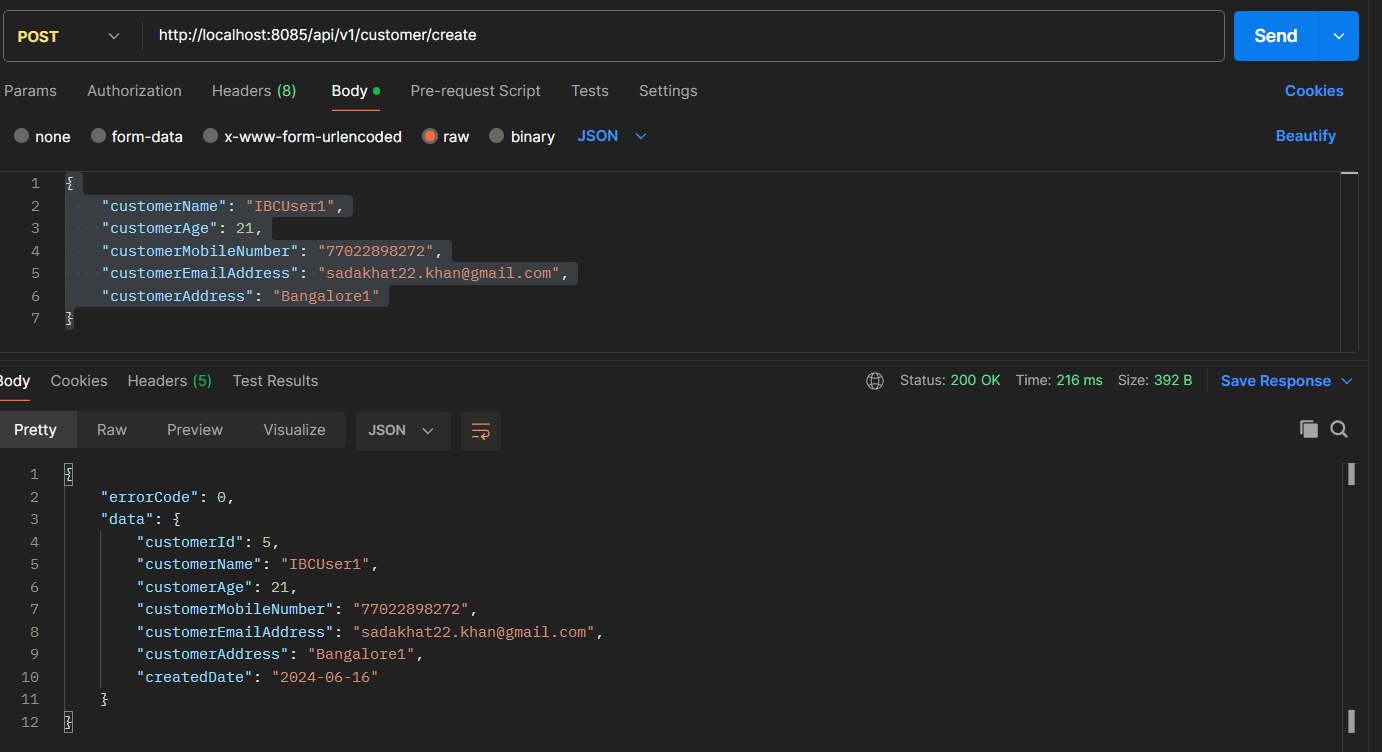
Get all the customer
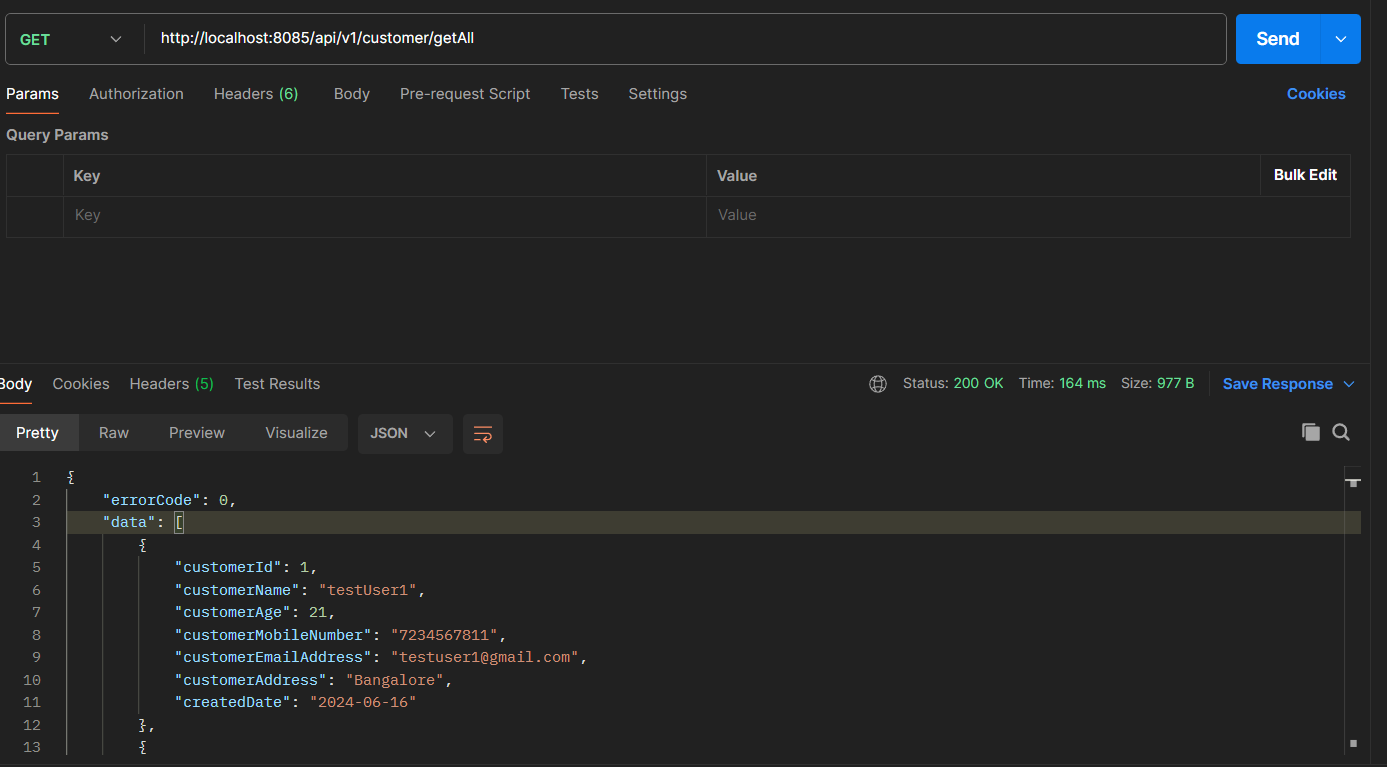
Get customer by id
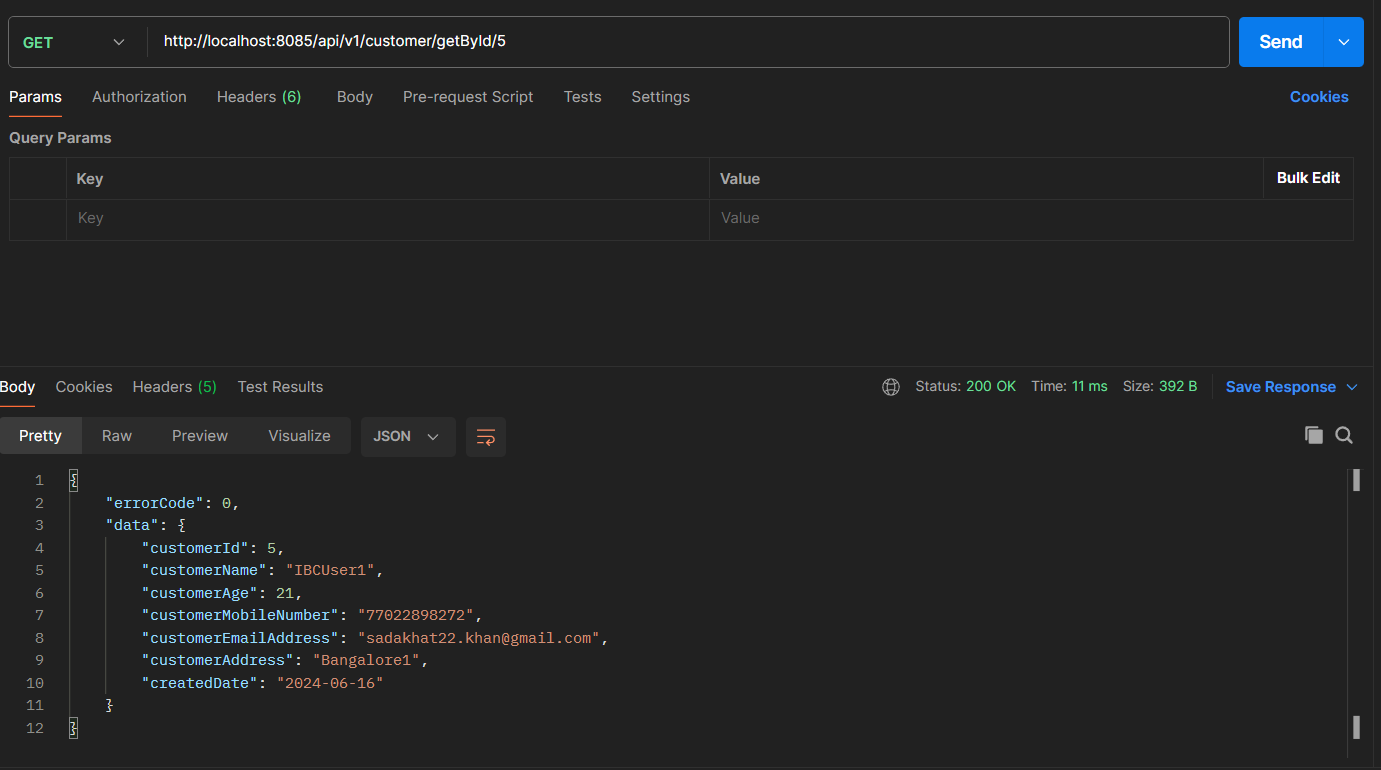
Delete a customer by id
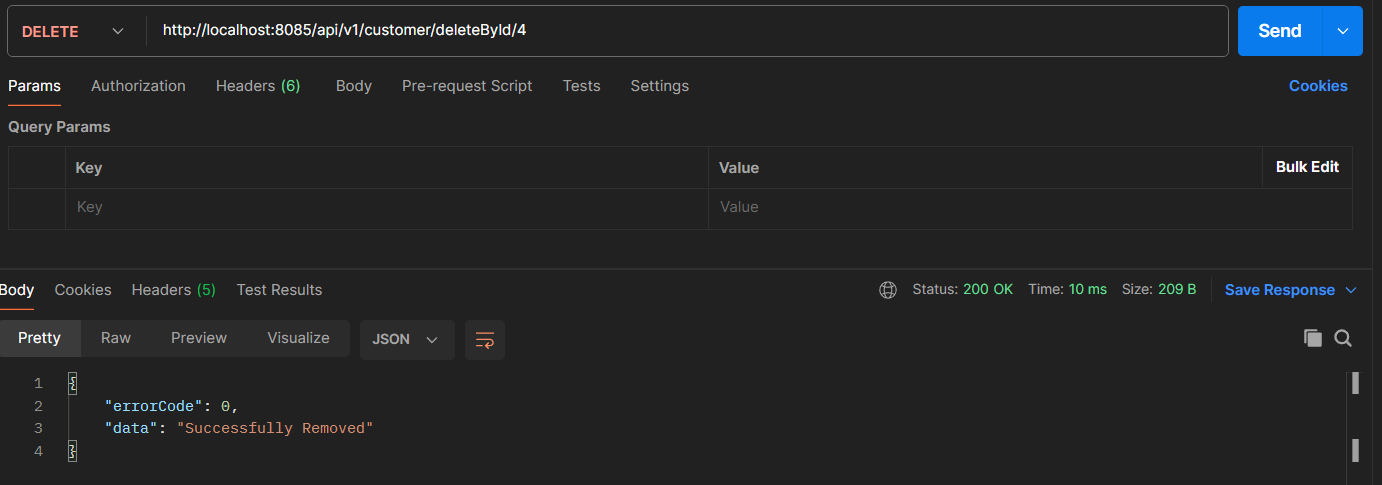
Update a customer by id and object
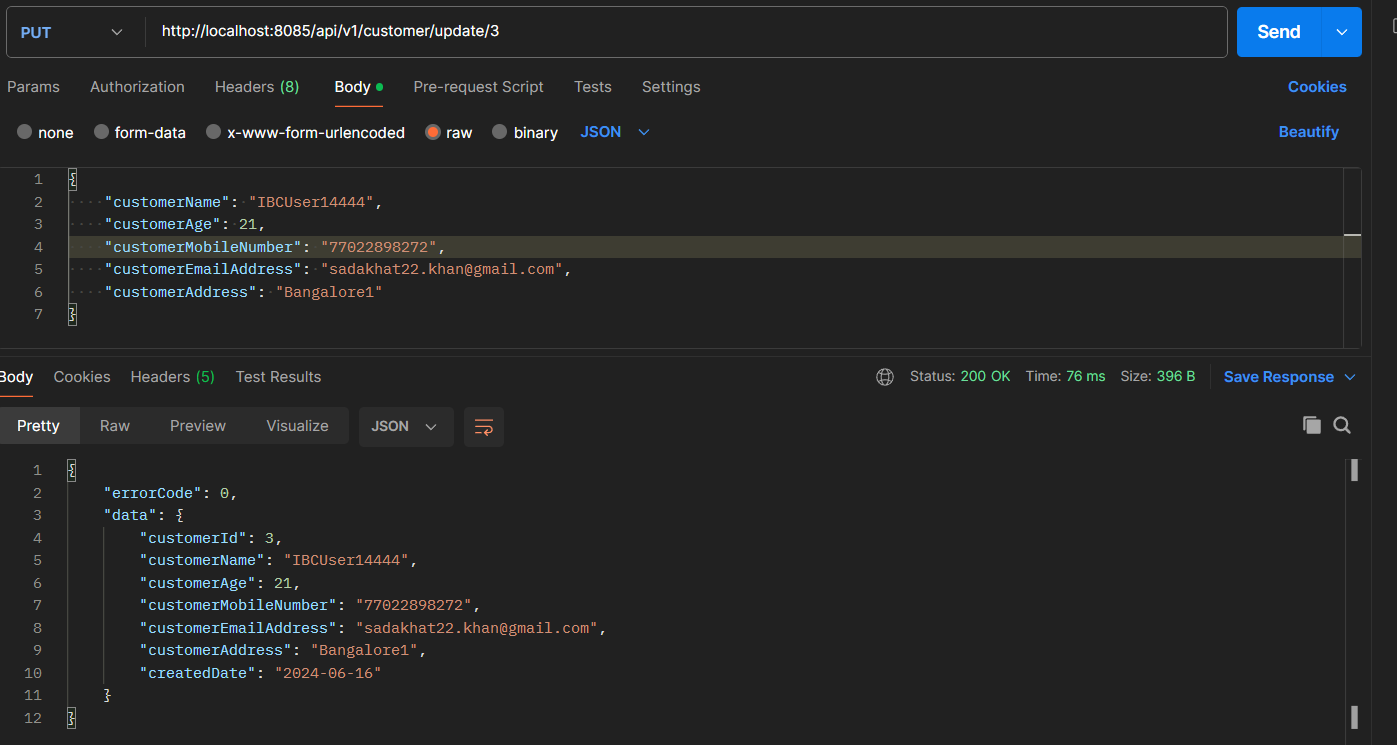
Full source code is available in follwong GitHub repository: CRUD example